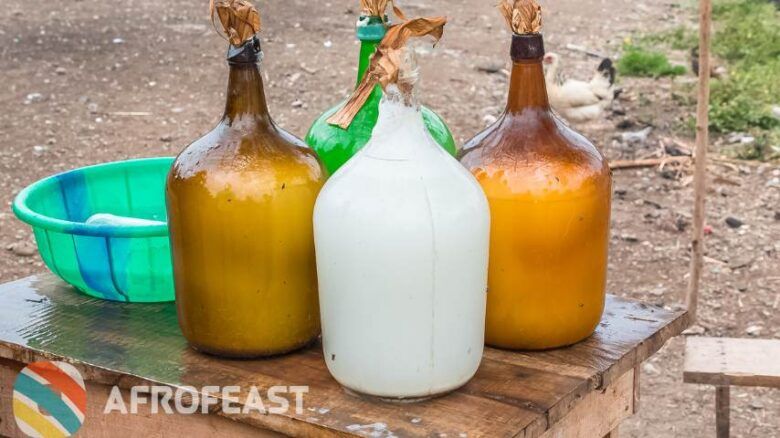West African sunshine warms your skin, and the sky is painted in fiery oranges and deep purples. You’re relaxing under a giant palm tree, its leaves whispering secrets in the breeze. In your hand is a cool calabash cup filled with a cloudy, fizzy drink—that’s palm wine, a delightful treat that’s been enjoyed for centuries in West Africa.
Palm wine is more than just a refreshing drink. It’s about sharing stories with friends under the shade, the clinking of calabashes in a toast, and the satisfying sensation of a cool drink on a hot day. But what exactly is palm wine? Let’s explore how it’s made, what it tastes like, and why it’s such an integral part of West African culture.
1. From Treetop to Cup: The Palm Wine Journey
The story begins with the tall palm trees, a familiar sight across West Africa. These aren’t just any trees; they’re the source of the magic—their sweet, clear sap. With skills honed over generations, tappers climb the trees with ease and use special tools to collect this sap from the flower stalk. It’s like giving the tree a tiny cut so the sweet sap can flow freely. This is done carefully to ensure the tree remains healthy and continues to produce this delicious sap.
The collected sap isn’t quite ready for drinking yet. Here’s where things get interesting. The sap is poured into clay pots or calabashes and left to ferment naturally. Tiny invisible helpers (yeasts) inside the sap take the sugars and turn them into alcohol, creating that bubbly, slightly boozy drink. This whole process can take a few hours or even an entire day, depending on how strong and flavourful you want your palm wine.
2. The Many Faces of Palm Wine
Palm wine isn’t a one-trick pony. The taste can change depending on the type of palm tree used, how long it’s been fermenting, and even where you’re drinking it. Generally, fresh palm wine is on the sweeter side, a bit yeasty with a hint of nutty flavour. As it ferments longer, the sweetness fades, and it becomes more tart and boozy. Some people even say it tastes like a light cider or champagne.
The real fun part is the variety. In Nigeria, for example, palm wine from the raffia palm has a smoky smell, while those from date palms are known for being sweeter. In Ghana, they sometimes add ginger or other spices to the sap before fermenting, giving the palm wine a whole new flavour dimension.
3. More Than Just a Drink: The Soul of Palm Wine

Palm wine is much more than just a way to beat the heat. It’s a social glue that brings people together, symbolises traditions, and even provides a livelihood for some. It’s a common sight at village gatherings, celebrations of all kinds, and even funerals. Sharing a calabash of palm wine is like sharing a piece of yourself, creating a sense of connection and community.
Palm wine also has a spiritual side in some parts of West Africa. It might be used in ceremonies as an offering to ancestors or to bring good luck. The techniques for tapping and making palm wine are often passed down through families, preserving this rich cultural heritage.
4. The Changing Times: Palm Wine Today
While palm wine remains a significant part of West African life, times are changing. As cities grow, fewer people are tapping trees the traditional way. Additionally, bottled beers and wines are becoming more accessible. Some people also have concerns about the cleanliness and safety of traditionally made palm wine.
However, there are efforts to address these issues. People are working on ways to ensure tapping is done safely and hygienically. Bottled palm wine is also starting to appear in stores, making it easier for everyone to enjoy this delicious drink.
Closing Thoughts
Palm wine is a prime example of West African ingenuity and resourcefulness. It’s a tasty, refreshing drink, but more importantly, it’s a symbol of community, tradition, and a way of life. So, grab a calabash of palm wine next time you find yourself in West Africa under a shady palm tree on a scorching day.
For more insights into the rich culture of West Africa, visit Adventures of a Ghanaian Girl
